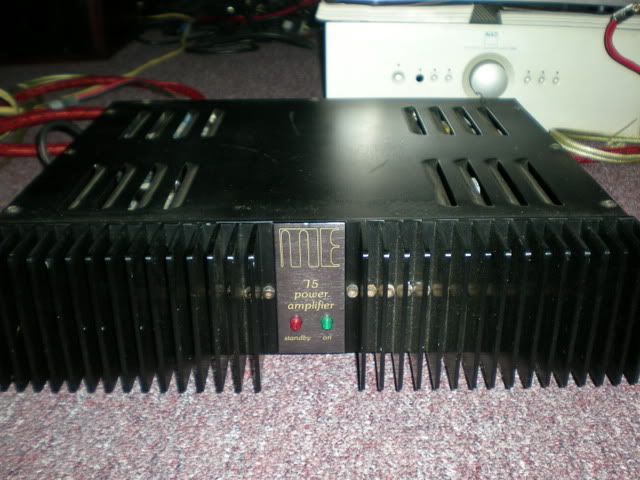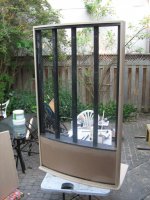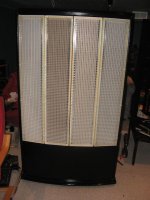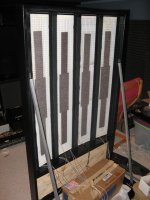Im using an Australian made amp, an ME-75. Extremely stable. I have used a variety of this brand over the years. This particular unit drove my Scintillas effortlessly to high levels. Re-capped with Nichicons and biased up to about 15w class A.
My speakers are the Model 6 I believe ? 4 x MK-121 Pwr Supplies, 3 panels across and two high.
Regards
Scott
So this is what you have, sorry for the model 6 i tought you had a pair of Spectra 11 your in a different ball park my friend as a Plinius SA-250MK1V with is Spectra6600 doesn't have your problems.
An externally hosted image should be here but it was not working when we last tested it.


So this is what you have, sorry for the model 6 i tought you had a pair of Spectra 11 your in a different ball park my friend as a Plinius SA-250MK1V with is Spectra6600 doesn't have your problems.
An externally hosted image should be here but it was not working when we last tested it.


I have compared the ME-75 against the Plinius in years gone by. With 40 amps (continous) 300w at 1ohm and stable into a dead short, the ME was a better performer, in my experience at least. Also, the bass on the ME was superior to the Plinius, maybe due to the Bi-Polar vs Mosfet outputs ?
Regards
Scott
One can certainly bypass the input capacitor with straight wire, but doing so can lead to saturation of the transformer, since it is not designed for low frequency operation. This will also lower the low-frequency impedance considerably, making the load more difficult for the amplifier.
A better choice, if one is interested in experimenting with this idea, is to parallel the input capacitor with a 1-ohm, 50-watt resistor. This will largely remove the high-pass filter, while reducing the likelihood of transformer saturation. If going this route, one can also remove the parallel resistor (10-ohm?) in the input network, whose only function is to form the highpass filter along with the capacitor. With the capacitor bypassed with a resistor, the parallel resistor will act as a voltage divider, wasting amplifier voltage swing.
Thanks for the hint. I'll high pass filter the signal at about 100 Hz, so transformer saturation would be less of a problem I think.
I'm thinking about placing two panels side by side and connecting all four half panels to the full range signal from the transformer (before the 330k resistors). This would reduce the horizontal dispersion of the high frequencies, but since it's twice the width I don't think this would be a big problem. Do you agree? Are there other disadvantages to this setup?
Thanks for the hint. I'll high pass filter the signal at about 100 Hz, so transformer saturation would be less of a problem I think.
I'm thinking about placing two panels side by side and connecting all four half panels to the full range signal from the transformer (before the 330k resistors). This would reduce the horizontal dispersion of the high frequencies, but since it's twice the width I don't think this would be a big problem. Do you agree? Are there other disadvantages to this setup?
I think you would be disappointed with the results of driving two panels with only the full range output of the transformer. The Spectra interface is designed to drive only a small area for high frequencies, and therefore the frequency response is compensated so the overall response comes out correctly. Simply put, you would have WAY too much high frequencies with all that additional panel area.
You would also be throwing away all that is magic about the Spectra series, that is, a speaker that decreases in width as frequency increases. Set-up as intended, Spectra yields a speaker with pin-point imaging while avoiding a very narrow listening window.
If you want to try a side-by-side arrangement, try wiring it this way (for the left speaker, counting from the left side): segment #1 and #2, mids only; segment #3, full range, and segment #4, mids only. The right speaker would be a mirror-image of the left one. This would be similar to the arrangement in the Spectra 22/2200, but obviously without much bass response. You'd probably also need to change the value of the 330K sector resistors to about 100K to keep the crossover frequency the same.
I have a 25+year old set of Acoustat +1 (I believe thats correct?). They have an attached woofer enclosure and since I didn't buy them new I'm not sure of the model#.
Years ago i installed the medallion upgrade and reconed the woofers and have enjoyed them thoroughly especially since I added on an audio/visual room (19' x 24'-with a stepped ceiling) and bought both a Lexicon MC-12 and two Lexicon/Bryston mono amps to drive them. #1-I need some advice if there is any any upgrades the Acoustat answer man can offer? and #2 if the existing wire terminals/posts can be replaced as I have a terrible time making a tight mechanical connection to the speaker cables with the banana clips I'm using.
Thanks for any help you can offer.
Years ago i installed the medallion upgrade and reconed the woofers and have enjoyed them thoroughly especially since I added on an audio/visual room (19' x 24'-with a stepped ceiling) and bought both a Lexicon MC-12 and two Lexicon/Bryston mono amps to drive them. #1-I need some advice if there is any any upgrades the Acoustat answer man can offer? and #2 if the existing wire terminals/posts can be replaced as I have a terrible time making a tight mechanical connection to the speaker cables with the banana clips I'm using.
Thanks for any help you can offer.
Yes Scott your speakers are the model 6s included is a photo of your amp and Jocelyn's model 6 speaker before he made them into Spectra 6600s. André


An externally hosted image should be here but it was not working when we last tested it.
An externally hosted image should be here but it was not working when we last tested it.
I have a 25+year old set of Acoustat +1 (I believe thats correct?). They have an attached woofer enclosure and since I didn't buy them new I'm not sure of the model#.
Years ago i installed the medallion upgrade and reconed the woofers and have enjoyed them thoroughly especially since I added on an audio/visual room (19' x 24'-with a stepped ceiling) and bought both a Lexicon MC-12 and two Lexicon/Bryston mono amps to drive them. #1-I need some advice if there is any any upgrades the Acoustat answer man can offer? and #2 if the existing wire terminals/posts can be replaced as I have a terrible time making a tight mechanical connection to the speaker cables with the banana clips I'm using.
Thanks for any help you can offer.
Replacing the binding posts is both possible and a good idea. The originals were not all that great. The only caution might be that some alternate binding posts may require a larger hole in the chassis, which would require some careful drilling or filing (make sure no bits of metal remain in the chassis!).
Since you already did the Medallion modification, and reconed the woofer, there's not much else to do. There is an electrolytic capacitor in the audio path (220-uF?) that could be replaced with a polypropylene or other premium type, but that large a value can be quite large (and expensive).
Yes Scott your speakers are the model 6s included is a photo of your amp and Jocelyn's model 6 speaker before he made them into Spectra 6600s. André

An externally hosted image should be here but it was not working when we last tested it.
An externally hosted image should be here but it was not working when we last tested it.
Thats the amp ! The woodwork on the the Spectras is very nice. Are the frames wooden, or is there a steel frame underneath ?
Regards
Scott
I've gotten hold of a second pair of Spectra 11's (even cheaper than the first pair  ) and did some measurements today. I bypassed the high pass filter, disconnected the Spectra woofer and set the crossover for the subs at 100 Hz. The panel drops quite steeply below 250 Hz so there was a quite big "valley" in the frequency response before the subs took over. However, the sound was very crisp and clear with better highs, but I also heard some pops/cracks (panel discharges?), which made me a bit worried.
) and did some measurements today. I bypassed the high pass filter, disconnected the Spectra woofer and set the crossover for the subs at 100 Hz. The panel drops quite steeply below 250 Hz so there was a quite big "valley" in the frequency response before the subs took over. However, the sound was very crisp and clear with better highs, but I also heard some pops/cracks (panel discharges?), which made me a bit worried.
Connecting a second panel in parallell to the same interface made the frequency valley a bit less deep, but it would require some kind of digital EQ compensation to run the panels flat down to 100 Hz. Maybe the easiest option is to get hold of a pair of Spectra 22/2200 interfaces or transformers (if anyone has some for sale I'm interested ). Meanwhile I think I'll just replace the high pass caps with better ones.
). Meanwhile I think I'll just replace the high pass caps with better ones.
Connecting a second panel in parallell to the same interface made the frequency valley a bit less deep, but it would require some kind of digital EQ compensation to run the panels flat down to 100 Hz. Maybe the easiest option is to get hold of a pair of Spectra 22/2200 interfaces or transformers (if anyone has some for sale I'm interested
Thats the amp ! The woodwork on the the Spectras is very nice. Are the frames wooden, or is there a steel frame underneath ?
Regards
Scott
Hi Scott, the frame is 2x4 steel covered with mahogany wood each speakers weigh around 600 pounds each
I've gotten hold of a second pair of Spectra 11's (even cheaper than the first pair) and did some measurements today. I bypassed the high pass filter, disconnected the Spectra woofer and set the crossover for the subs at 100 Hz. The panel drops quite steeply below 250 Hz so there was a quite big "valley" in the frequency response before the subs took over. However, the sound was very crisp and clear with better highs, but I also heard some pops/cracks (panel discharges?), which made me a bit worried.
Connecting a second panel in parallell to the same interface made the frequency valley a bit less deep, but it would require some kind of digital EQ compensation to run the panels flat down to 100 Hz. Maybe the easiest option is to get hold of a pair of Spectra 22/2200 interfaces or transformers (if anyone has some for sale I'm interested). Meanwhile I think I'll just replace the high pass caps with better ones.
I am not at all surprised by your results. Neither the 11/1100 transformer or a single panel will have much response below 200 Hz. Adding more panel area will help some, but you are still limited by the LF response of the transformer. LF performance is what makes a transformer expensive, and it's no wonder that the full range Spectra's have about eight times more 'iron' in the transformers.
I am also not surprised at the increase in crackling of the panel. You are probably running into some saturation of the transformer, plus a single panel can act that way when you are trying to run it full range. However, it is highly unlikely you have caused any damage to the panel. This is why all of Acoustat's single-panel models are hybrids.
I guess the moral of the story is that you can't make a silk purse out of a sow's ear (not that I would suggest that the Spectra 11 is a sow's ear).
Do you know the specs/model of the Spectra 2200/3300 transformers? Is it something you can buy off the shelf?I am not at all surprised by your results. Neither the 11/1100 transformer or a single panel will have much response below 200 Hz. Adding more panel area will help some, but you are still limited by the LF response of the transformer. LF performance is what makes a transformer expensive, and it's no wonder that the full range Spectra's have about eight times more 'iron' in the transformers.
Andy Szabo2007-10-07 23:24Do you know the specs/model of the Spectra 2200/3300 transformers? Is it something you can buy off the shelf?
The MK-2123 interface was common to Acoustat Models Spectra 22/2200, and 33/3300. An internal wiring difference changed the bass equalization for either the two-panel 22/2200, or the three-panel 33/3300. There should be a rubber-stamped number on the interface label indicating whether the interface is set-up for a 22/2200 or 33/3300. If for some reason that stamp is not visible, the speaker can be identified by its width: the cloth-covered portion of the 22/2200 frame will measure 21.5" wide, and the 33/3300 will measure 31.75" wide. The only difference between the 22/33 and the later 2200/3300 is the cosmetic wood and brass strips along the sides of the panel. The panels and interface electronics are identical.
You can find most of your answers here this is the Acoustat bible.
Acoustat
Do you know the specs/model of the Spectra 2200/3300 transformers? Is it something you can buy off the shelf?
All Acoustat transformers were custom-made, so are not available 'off the shelf'. However, there may be some NOS or used parts that you may be able to find. Keep in mind that each full-range Spectra uses two identical audio transformers, one for each phase. So you need four for a stereo pair. Also keep in mind that the full-range Spectras use a more complicated high-voltage combining and sector-dividing network, so that must be created as well if you intend to build a full-range (or at least down to 100-Hz) speaker. There are also complete, used speakers available, so that might be an easier route.
Hi Andy
Here is my attempt at a Monitor 4/ Spectra 44. There are 4 x 9" panels at a 6 degree angle. 2 panels are 3 wire and 2 panels are 5 wire .I am going to drive them with a MK121C interface initally. I also have a Spectra MK2123 interface .My question is can I drive the 4 panels with the Spectra 33 tap ,or will there be too much bass?
Thanks
Andrew
Here is my attempt at a Monitor 4/ Spectra 44. There are 4 x 9" panels at a 6 degree angle. 2 panels are 3 wire and 2 panels are 5 wire .I am going to drive them with a MK121C interface initally. I also have a Spectra MK2123 interface .My question is can I drive the 4 panels with the Spectra 33 tap ,or will there be too much bass?
Thanks
Andrew
Attachments
Hi Andy
Here is my attempt at a Monitor 4/ Spectra 44. There are 4 x 9" panels at a 6 degree angle. 2 panels are 3 wire and 2 panels are 5 wire .I am going to drive them with a MK121C interface initally. I also have a Spectra MK2123 interface .My question is can I drive the 4 panels with the Spectra 33 tap ,or will there be too much bass?
Thanks
Andrew
Sorry Andrew very nice model 4s but NOT 44s or 4400s because those need to be 22 inches wide by 94 inches high like these next to a pair of model 3s models -2 - 3 - 4 - are all about 66 inches high. André
An externally hosted image should be here but it was not working when we last tested it.
An externally hosted image should be here but it was not working when we last tested it.
Sorry Andre
You obviously don't get it, see post #38
See here http://www.diyaudio.com/forums/planars-exotics/183168-acoustat-answer-man-here-4.html
Andrew
You obviously don't get it, see post #38
See here http://www.diyaudio.com/forums/planars-exotics/183168-acoustat-answer-man-here-4.html
Andrew
Sorry Andre
You obviously don't get it, see post #38
See here http://www.diyaudio.com/forums/planars-exotics/183168-acoustat-answer-man-here-4.html
Andrew
Ok Andrew did not notice that particular post but one thing i can tell you is that i had a friend like you that could not fit his Acoustat's 2+2s in his basement for the same reason ( height ) he did what you did 4 panels side by side they realy sounded good BUT did not sound like normal 2+2s BUT better than any boxed speaker at the same price
PS: They do look very nice ENJOY
I agree with you, MrAcoustat, the 1+1s are a wonderful speaker. My next project will be to "Spectra" mine -- to improve horizontal dispersion a little -- and add either a single plane bass array or a double bass array; then I am done! I promise!
QUOTE: Then I am done, I and my wife have heard that statement before
Nice job, Andy. You're going to end up with a totally unique Acoustat. I'm very curious to hear about how combining the standard and Spectra interfaces turns out. Hopefully after zeroing in on the interface config you WILL be done, but no one here will hold you to your promise. 
- Home
- Loudspeakers
- Planars & Exotics
- Acoustat Answer Man is here


